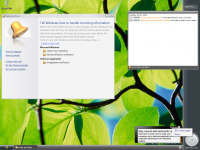Windows Sidebar
The Windows Sidebar is a feature first seen in Windows "Longhorn", and later present in the Windows Vista and Windows 7 operating systems developed by Microsoft.
The Channel Bar included with the Windows Desktop Update, the MSN Dashboard, and the later Microsoft Sideshow application can be seen as precursors to the Windows Sidebar.
Precursors
Windows Desktop Update
A feature called Channel Bar was integrated with Internet Explorer 4 as part of the Windows Desktop Update, and was later included with the Windows 98 operating system.
The Channel Bar was designed to be an information delivery system based on Microsoft's Channel Definition Format (CDF). Users could subscribe to various channels - websites designed to deliver content - and receive updates from the channel provider. Due to its integration with Active Desktop, information could also be displayed within Windows Explorer or in the Channel Screensaver.
Microsoft Sideshow
Microsoft demonstrated an application called Windows Sideshow during the Professional Developers Conference of 2001. This application hosted scripts (called Tickets) on a Sidebar to display live information pertaining to contacts and e-mail, news, traffic updates, and weather forecasts.
Windows Sideshow is compatible with Windows 2000, Windows ME, and Windows XP, and can be made to run on older versions of the Windows operating system. If one attempts to change the application's appearance in versions of Windows later than Windows XP, a bug causes its appearance to become completely black.
A video presentation of Windows Sideshow is available on YouTube.
Windows "Longhorn"
The first and most notable version of the Windows Sidebar was included with Windows "Longhorn", first seen in 3683 of the operating system. This version of the Windows Sidebar used applets called Tiles to display dynamically updated content. Later builds allowed the Windows Sidebar to be combined with the taskbar.
From builds under the 3xxx branch and up to 403x, the appearance of Windows Sidebar matched the Plex theme and was translucent without assistance from the Desktop Composition Engine. Microsoft later scrapped the Plex theme for the Slate visual style; as a result of this, the Sidebar's appearance changed to a glossy black, but could be made translucent in build 4074 by enabling the MILDesktop key in the Windows Registry. The Windows Sidebar was not included in the 64-bit builds of the operating system.
In addition to displaying dynamically updated content, the Sidebar intended to replace the previous notification system and provide a centralized location for application alerts, system alerts, notifications, and other information.
Later in development, the applets called Tiles were renamed to Parts.
The last known build of "Longhorn" to include Windows Sidebar was build 4093. Its appearance changed to a glossy variation of the Slate theme.
Omega-13 stage
After the development "reset" of Windows "Longhorn", the Windows Sidebar was not seen again until after the release of Windows Vista 5219. Unlike the version in Windows "Longhorn", this Sidebar was not integrated with the Windows shell, but did host graphical scripts on a vertical strip.
Parts were later renamed to Gadgets, with variations of individual Gadgets being included in the operating system throughout its development.
Windows Vista
Windows Vista includes a total of eleven Gadgets: Calendar, Clock, Contacts, CPU Meter, Currency, Feed Headlines, Notes, Picture Puzzle, Slide show, Stocks, and Weather.
Windows 7 and onward
During development of Windows 7, the user interface for Windows Sidebar was removed, which made the desktop the sole location for Gadgets. New features included larger Gadget options, DPI scaling, and a new Media Center Gadget.
In early builds of Windows 7, Gadgets could not be aligned properly.
Windows 8 included the Windows Gadget Platform up until the Release Preview; it was removed in the RTM version of the operating system. Microsoft stated that it is possible for arbitrary code to be executed while running insecure Gadgets, and released a tool to disable the feature in Windows Vista and Windows 7. The new Start screen with its Live Tiles feature supersedes the Windows Gadget Platform.
Microsoft shut down the Windows Desktop Gadget Gallery website on October 1, 2011, stating that it wanted to focus on the "exciting possibilities of the newest version of Windows."
